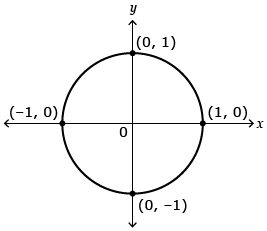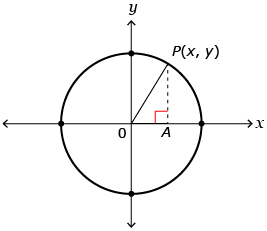Explore
In Try This 1 you took a circle and divided it into sections that were multiples of ![]() and
and ![]() You may have determined that the radius of the circle you made is 1 unit, since the distance around the circle, or the circumference, was 2π.
You may have determined that the radius of the circle you made is 1 unit, since the distance around the circle, or the circumference, was 2π.


Source: Adapted from Pre-Calculus 12. Whitby, ON: McGraw-Hill
Ryerson, 2011. Reproduced with permission.
A circle with a radius of 1 and the centre at the origin can be called a unit circle.
Now that you have found some values for points on a unit circle, you can derive an equation to represent all points on a unit circle. You will use the Pythagorean theorem.
Try This 2
Step 1: Draw a unit circle on an x- and y-axis. This means that you will draw a circle with a radius of 1 and the centre of the circle at the origin (0, 0).
Step 2: Label the centre of the circle O.
Step 3: Pick any point in quadrant 1 of the unit circle. Label the point P(x, y).
Step 4: Draw a line from point O to point P. What is the length of this line segment? ![]()
Step 5: Label OP on the diagram.
Step 6: Create a right-angle triangle by drawing a vertical line from point P to the x-axis. Label the point on the x-axis A. ![]()
- What is the length of line segment PA? Label this length.

- What is the length of line segment OA? Label this length.

- Since this is a right-angle triangle, use the Pythagorean theorem to write an equation that relates the lengths of OP, PA, and OA.
![]() Save your responses in your course folder.
Save your responses in your course folder.
Share 2
With a partner or in a group, discuss the following questions.
- Share the equation you wrote in Try This 2 question 3.
- Would your equation change if you chose a different point P?
- What would happen if point P were in quadrant 3? Would this change the lengths of PA and OA?
![]() If required, save a record of your discussion in your course folder.
If required, save a record of your discussion in your course folder.
